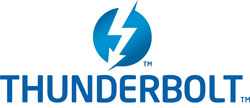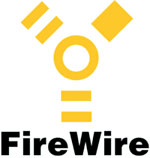 Developed by Intel, the 10Gb/s bi-directional interface is technically PCI Express on a cable. It was originally designed to use fiber optics, but Intel later went with copper wiring as a mean to reduce cost and to supply power. The expansion bus can support both hubs as well as a daisy chain of up to 7 devices. Thunderbolt, which supersedes Mini DisplayPort on the latest Macs, has made way into all Apple laptops and desktops, except the Mac Pro.
Developed by Intel, the 10Gb/s bi-directional interface is technically PCI Express on a cable. It was originally designed to use fiber optics, but Intel later went with copper wiring as a mean to reduce cost and to supply power. The expansion bus can support both hubs as well as a daisy chain of up to 7 devices. Thunderbolt, which supersedes Mini DisplayPort on the latest Macs, has made way into all Apple laptops and desktops, except the Mac Pro.
While Thunderbolt is widely reported as USB 3.0 killer, it is not really a competing standard. Rather it is more a niche interface, whereas USB is more of a mainstream port. Say if you have a need to capture multi-HD stream and save the video feed into a SSD RAID on a daily basis, then all by means Thunderbolt is a viable option for you. For everyone else, Thunderbolt maybe an overkill. USB 3.0 and Thunderbolt, metaphorically speaking, are a good quality highway and peripherals are race cars. Taking the car to maximum speed without even touching the speed limit of highway itself is like copying 10GB or so of data to a 5400-rpm portable drive thru Thunderbolt. In this case, USB 3.0 can complete the transfer fairly quickly (minute and a half if speed is at 110MB/s) without the cost premium of Thunderbolt.
To leverage the full potential of Thunderbolt, you need some high end components that will take you beyond 500MB/s at which speed will definitely dwarf USB 3.0, but they will also add to the cost of Thunderbolt products. There is, however, a limited number of applications that require such transfer rate and that only prosumers and professionals can tell whether or not the increase in performance justifies the added cost. For this reason, Thunderbolt won’t be going mainstream anytime soon. On the other hand, USB 3.0 and USB 2.0 have almost reached price parity and it’s a no-brainer to pick the former for everyday tasks.
In summary, Thunderbolt and USB 3.0 has their own respective strengths, and consumers can decide which route to go based on their budget and requirements.
 USB 3.0 (5Gbps) is theoretically 10 times faster than USB 2.0 (480Mbps). You can expect three-fold to ten-fold increase in performance with current generation of USB 3.0 devices but your mileage varies depending on the type of device.In real world, you’re going to see a SandForce-based flash drive topping 250MB/s and a 5400-rpm portable drive reaching 100MB/s. USB 3.0 also provides more power, 900mA up from 500mA of USB 2.0. This will allow some demanding devices, namely USB monitors and RAIDs, to be powered with just one cable.
USB 3.0 (5Gbps) is theoretically 10 times faster than USB 2.0 (480Mbps). You can expect three-fold to ten-fold increase in performance with current generation of USB 3.0 devices but your mileage varies depending on the type of device.In real world, you’re going to see a SandForce-based flash drive topping 250MB/s and a 5400-rpm portable drive reaching 100MB/s. USB 3.0 also provides more power, 900mA up from 500mA of USB 2.0. This will allow some demanding devices, namely USB monitors and RAIDs, to be powered with just one cable.
Despite the USB 3.0’s advantages, USB 2.0 already serves as the ideal interface for a number of applications as it provides ample of bandwidth in these situations. USB 3.0, in this case, isn’t necessary and could increase the cost. For the reason, the market for USB 2.0 devices of all types isn’t going to dwindle in short to medium term.
 The interface has long been the “forgotten” mass market, high-speed interface standard. Previously available in Firewire 400 or 800 flavors, it has gradually fallen in popularity as USB 2.0 and 3.0 has surged. Apple, the inventor of the original IEEE 1394 “Firewire” standard, has repeatedly sent mixed messages with the ditching of Firewire first from iPods and more recently from the mainstream MacBook laptops (except for the lowest-end MacBook, oddly enough).
The interface has long been the “forgotten” mass market, high-speed interface standard. Previously available in Firewire 400 or 800 flavors, it has gradually fallen in popularity as USB 2.0 and 3.0 has surged. Apple, the inventor of the original IEEE 1394 “Firewire” standard, has repeatedly sent mixed messages with the ditching of Firewire first from iPods and more recently from the mainstream MacBook laptops (except for the lowest-end MacBook, oddly enough).
Firewire’s main claim to fame is that it is a highly efficient peer-to-peer, full-duplex, non-polling data communications protocol with very low overhead. Firewire delivers much higher actual throughput than USB 2.0 and can achieve much closer to its theoretical 800Mbit/s data rate than USB. Where a Firewire 800 7200-rpm hard drive can deliver sequential transfer rate of around 90MB/s, USB 2.0 hovers more around 40MB/s and USB 3.0 averages at 150MB/s. USB 3.0 has since improved significantly with the latest flash drives reaching 350MB/s, largely thanks to recent advances in flash controllers and improved driver stacks.
In late 2007, the 1394 Trade Association announced Firewire 3200 (S3200) that builds upon the existing Firewire 800 standard that was released in 2002. Utilizing the very same connectors and cabling that is required for Firewire 800, S3200 is basically a drop-in replacement once the internal system components are updated in devices. To date, S3200 has not gained much traction, even in traditional Firewire markets such as digital video.
As of 2016, FireWire (all flavors) appears to be all but gone on recently shipped laptops and desktops. You can, however, still find FireWire 800 on many Thunderbolt 2 docks. And if you really want it, aftermarket PCI Express cards are still widely available.
 Brought to market in 2004 as a consumer interface targeted directly at the crowded external storage market, eSATA successfully address the issue of the interface bottleneck, and allowed fast hard drives to leverage their performance potential when located external to a server or PC.
Brought to market in 2004 as a consumer interface targeted directly at the crowded external storage market, eSATA successfully address the issue of the interface bottleneck, and allowed fast hard drives to leverage their performance potential when located external to a server or PC.
eSATA supports a data rate of 3.2Gbps, which is more than enough for the fastest hard drives, which can transfer about 120MB/s, easily better than USB 2.0 and significantly better than Firewire 800.
It is not without drawbacks, however. Cable length is limited to a mere 2; it cannot supply power to devices connected on the eSATA bus, and the connectors are neither small nor terribly suitable for consumer devices where aesthetics are important. Over the last several years, eSATA has steadily eroded both USB and Firewire market share in the data storage space, although its applications are limited, and really not well-suited to the portable device market.
Nexcopy manufactures a variety of PC-based and standalone USB duplicator solutions.
PC based systems support advanced USB functions such as write protection, CD-ROM partition and multi-partition creation, while standalone systems are ultra-fast, high speed USB copiers duplicating gigabytes of data quickly and accurately.

